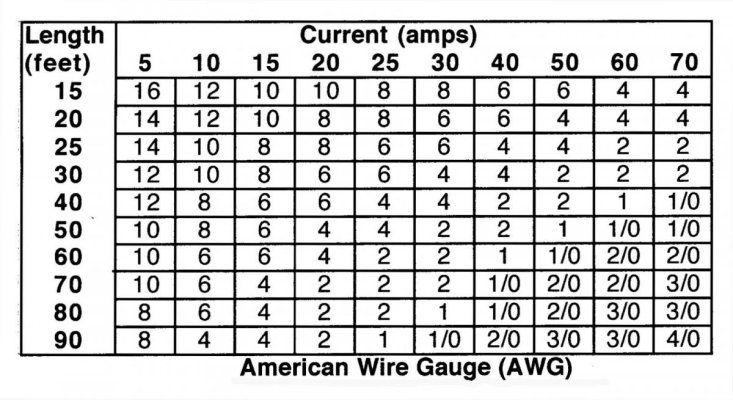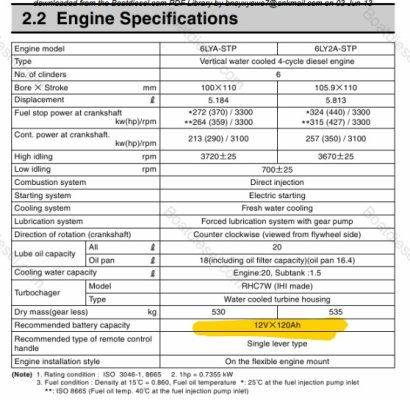The Yanmar 6LP was originally developed by Toyota for use in their Landcruiser. So I bet they didn't use a 4D or 8D to start it. I am guessing here that normal starting current is 500 or so amps and that is why a Group 31 battery which runs from 800-1,000 CCA can be used to start it and most diesels up to 6 liters. I know member Ski in NC uses a G31 to start his 8.3 liter Cummins.
So with that 500A figure in mind and a total of 13' 1/0 one way, you will have a voltage drop of 1.3 volts which brings the voltage at the starter terminals down to 12.6-1.3 = 11.3. I think anything better than 11.0 is ok. But with a 50% discharged battery it might not start since your no load voltage will be down to 12.0 volts..
2/0 brings the voltage drop down to 1.0 volts and 4/0 down to 0.7 volts.
So I would wire it with 2/0 at least.
David
I appreciate your advise. The Yanmar 6LPA-STP2 specs call for a battery with at least 120 amp hours.
Group 31.....105 amp hrs (x2 =$910.40 w/tax)
4D..............210 amp hrs ($852.85 w/tax)
So I'm either a bit under min. spec., or I'm way over min. spec. If I compare the cost of a single 4D vs 2 x Group 31 in parallel, the 4D is cheaper. I'm sure I could get away with installing an undersized battery, but I would prefer too much than too little. As that undersized battery gets older, so does its capacity and ability to discharge.
The entire cabling for the engine has not been changed, it has been in place for many years, and I suspect came from the factory. It is 1/0 from the starting battery to the battery switch to the engine. The entire run can't be more than about 15 feet. At 20 feet a 12v circuit at 60 amps can be handled by an 4 gauge wire.
Now, that being said. Please allow me to clarify....
While I outlined my entire project, I'm specifically asking about the 2 x 8D batteries which comprise my
HOUSE BANK.
Specifically the cable which connects Pos. to Pos. and Ground to Ground between the 2 8D's in the house bank wiring to the 2 8D's in parallel.
In my caser, I suspect the largest amp load on the circuit could potentially be the alternator (80amps). The alternator is only 5 feet from the starting battery and about 8 feet from the house bank.
I did notice that the windlass and 2000W inverter were both using 2/0. I suppose if I go to 2/0 it will at least be as large as the largest circuit and, as mentioned can't hurt anything.
I continue to welcome all thoughts, opinions, suggestions, and corrections.




